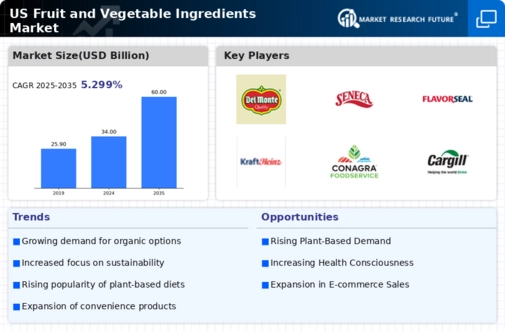Growing Health Consciousness
The increasing awareness of health and wellness among consumers is a pivotal driver for the fruit vegetable-ingredients market. As individuals become more informed about the nutritional benefits of fruits and vegetables, there is a marked shift towards incorporating these ingredients into daily diets. This trend is reflected in the market, where the demand for natural and organic fruit vegetable-ingredients has surged, with a reported growth rate of approximately 8% annually. Consumers are actively seeking products that offer health benefits, such as vitamins, minerals, and antioxidants, which are abundant in fruit and vegetable ingredients. This growing health consciousness is influencing food manufacturers to innovate and reformulate their products, thereby expanding the fruit vegetable-ingredients market. The industry is likely to continue evolving as more consumers prioritize health in their purchasing decisions.
Expansion of the Snack Food Segment
The expansion of the snack food segment is a significant driver for the fruit vegetable-ingredients market. With the increasing trend towards healthier snacking options, consumers are seeking snacks that incorporate fruits and vegetables. This shift is leading to the development of innovative snack products that utilize fruit vegetable-ingredients, such as fruit bars, vegetable chips, and smoothies. Recent market analysis indicates that the healthy snack segment is expected to grow by 12% in the coming years. This growth is prompting manufacturers to invest in research and development to create new snack products that appeal to health-conscious consumers. As the snack food market continues to evolve, the fruit vegetable-ingredients market is likely to benefit from this trend, providing opportunities for growth and innovation.
Rising Demand for Natural Food Colorants
The increasing demand for natural food colorants is a notable driver in the fruit vegetable-ingredients market. As consumers become more aware of the potential health risks associated with artificial additives, there is a growing preference for natural alternatives. Fruit and vegetable ingredients are being utilized not only for their nutritional benefits but also for their ability to provide vibrant colors to food products. The market for natural food colorants derived from fruits and vegetables is projected to grow at a rate of 7% annually. This trend is encouraging food manufacturers to explore innovative ways to incorporate these natural colorants into their products, thereby expanding the fruit vegetable-ingredients market. As the demand for clean label products continues to rise, the use of natural colorants is likely to become a standard practice in the industry.
Sustainability and Environmental Concerns
Sustainability has emerged as a critical driver in the fruit vegetable-ingredients market. Consumers are increasingly concerned about the environmental impact of their food choices, leading to a preference for sustainably sourced ingredients. This shift is prompting manufacturers to adopt eco-friendly practices, such as sourcing fruits and vegetables from local farms and utilizing organic farming methods. According to recent data, approximately 60% of consumers express a willingness to pay a premium for sustainably sourced products. This trend not only supports the growth of the fruit vegetable-ingredients market but also encourages innovation in sustainable packaging and production processes. As environmental awareness continues to rise, the industry is likely to see a greater emphasis on sustainability, influencing both consumer behavior and product development.
Technological Advancements in Food Processing
Technological advancements in food processing are significantly impacting the fruit vegetable-ingredients market. Innovations such as freeze-drying, high-pressure processing, and cold-press extraction are enhancing the quality and shelf-life of fruit and vegetable ingredients. These technologies allow for the preservation of nutrients and flavors, making it easier for manufacturers to incorporate these ingredients into various products. The market is witnessing a shift towards convenience, with ready-to-use fruit vegetable-ingredients gaining popularity among consumers. Recent statistics indicate that the processed fruit and vegetable segment is expected to grow by 10% over the next five years. As technology continues to evolve, it is likely to drive further growth in the fruit vegetable-ingredients market, enabling manufacturers to meet the changing demands of consumers.

















Leave a Comment